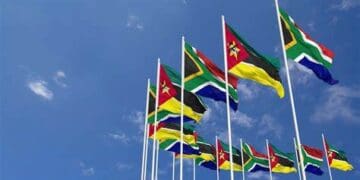South Africa’s newly announced policy on the use of radio frequency spectrum aims to bring small businesses into the digital economy but is already plagued by disagreement between the government and major industry players. Communications and Digital Technologies Minister Khumbudzo Ntshavheni announced the publication of the proposed Next Generation Radio Frequency Spectrum Policy for Economic Development last week, saying that the inclusion of SMMEs in the ICT sector would form an integral focus of the new policy.
Ntshavheni said the policy sought to promote SMME participation in the sector and enable the emergence of new entrants. But spectrum, which is licensed to network operators by the industry regulator ICASA, is notoriously expensive to acquire, and deploying the network infrastructure to use it for communications services puts it well beyond the reach of most SMMES.
In the spectrum auction recently concluded by ICASA, only the likes of Vodacom, Telkom, MTN, and Rain bid and acquired a new spectrum, spending a collective R14 billion. These companies expect to spend at least as much to deploy the spectrum to use it to offer telecoms and other digital services.
But Ntshavheni said the country had a plan to broaden access and participation of smaller players in an industry that is highly concentrated and dominated by large players. “While we acknowledge that due to limitations in the spectrum, it is not possible to license spectrum to all (of the) more than 400 Electronic Communications Networks (ECNS) and Electronic Clearance Services (ECS) license holders, the majority of which are SMMEs, we must continue with measures that will ensure that ultimately, SMMEs are included in the ICT sector including on access to spectrum,” she said.
One of the ways mooted to achieve this is a proposed state digital infrastructure company. The government would allocate spectrum to the entity, which would then lease it on favourable terms to SMMEs, youth- and women-owned entrants, and township-based businesses.
However, the idea of another state-owned company hasn’t found universal acceptance, even among industry groups representing SMME and black-owned companies in the sector. Many have criticised the policy for its seeming abandonment of the wireless open access network (WOAN), the publicly owned open network that the current policy says should facilitate wider participation in the sector.
Ntshavheni also emphasised that another intention of the new policy was to streamline regulation and eliminate regulatory burdens that threatened the sustainability of SMMEs in the sector. The policy would also encourage the wider use of spectrum in order to digitise other sectors of the industrial economy beyond communications and broadcast services. “In order to ensure social, cultural, and sustainable economic development, the revised Spectrum Policy seeks to consider services and applications from vertical industries and sectors such as agriculture, education, health, manufacturing, mining, etcetera,” she said.
“This will be on top of the traditional applications such as fixed, mobile and broadcasting.” The minister said the new policy would also address the long-standing issue of rural areas struggling with access to low-cost internet connectivity. “We continue to experience a connectivity divide resulting in the perpetual exclusion of rural, remote and underserved communities in the country.
“By making spectrum available, we will enable the telecommunications sector to build resilient networks in all geographic locations of our country.” While making the announcement, Ntshavheni also set out a timetable for the decommissioning of the older 2G and 3G networks, to free up more spectrum to expand 4G coverage and launch 5G throughout the country. This week Telkom criticised this plan, saying the 2025 deadline to turn off the 3G signal was “unrealistic”. The company pointed out that a significant number of its mobile customer base, particularly in rural and poorly covered areas, still relied heavily on 3G technology.
























































